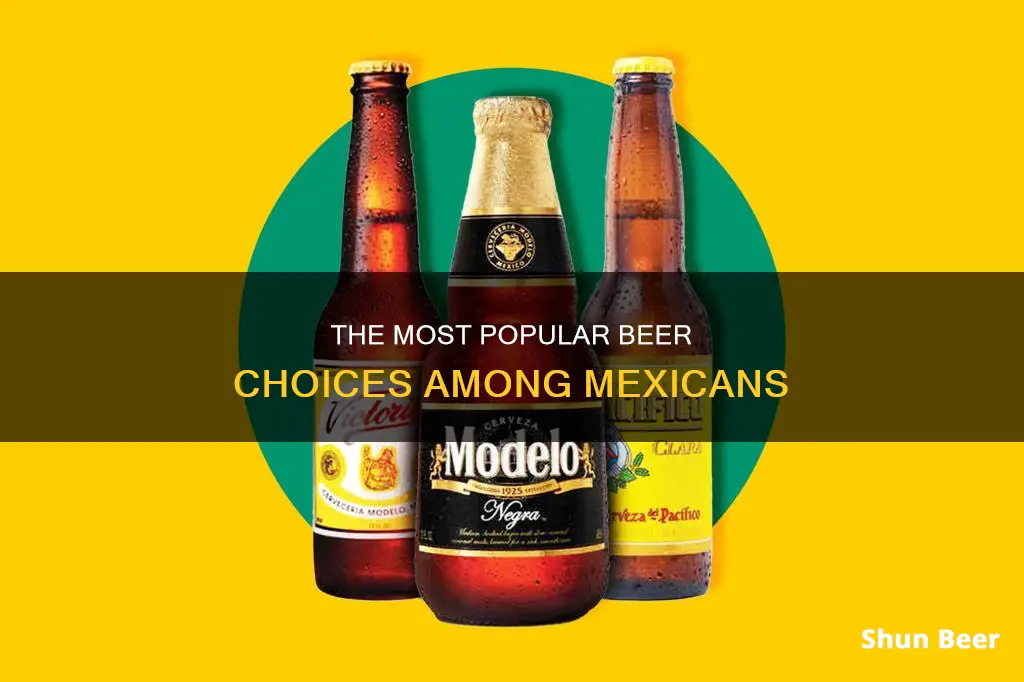
Mexico is the world's largest exporter of beer, with its beers particularly popular in the US and Europe. The country has a rich history of brewing, dating back to the Spanish conquest of the Aztec Empire in the 16th century. Even before this, ancient civilisations in Mexico were fermenting plants and corn grains to produce alcoholic beverages.
Today, most of the beers sold in Mexico are lagers, pilsners, Vienna-style light and dark beers, and Munich dark beers. The market is largely dominated by two brands, Grupo Modelo and FEMSA, which together supply over 90% of all beer in the country.
Some of the most popular Mexican beers include Corona, Tecate, Dos Equis, Sol, Victoria, Modelo, Pacifico, and Bohemia.
| Characteristics | Values |
|---|---|
| Most popular beer | Corona |
| Other popular beers | Tecate, Dos Equis, Sol, Modelo, Victoria, Pacifico, Carta Blanca, Bohemia, Leon, Montejo, Indio, Negra Modelo, Noche Buena, Cucapá Green Card, Buen Día Belgian IPA, Tempus Reserva Especial |
| Beer type | Pale lager, pilsner, Vienna-style light and dark beers, Munich dark beers |
| Beer ingredients | Barley, corn, plants, hops, syrup, malt, yeast, black malt, orange blossom honey, caramel, black malts, coriander, orange peel, wheat, cinnamon, nutmeg, cocoa, pasilla peppers, lime |
| ABV | 4-5% for most beers, with some as high as 10% |
| Beer cocktails | Michelada (beer with lime juice, salt, chilli powder, Worcestershire sauce, soy sauce, or tomato juice) |
| Beer snacks | Salty Mexican food |
What You'll Learn

Mexican beer history
The history of beer in Mexico dates back to the Spanish conquest of the Aztec Empire in the 16th century. While Mesoamericans had been brewing fermented alcoholic beverages, including corn beer, long before the Spanish arrived, the Europeans introduced barley and wheat-based beers to Mexico.
The first official concession to brew European-style beer was granted to Alfonso de Herrero in 1543 or 1544. However, production was limited during the colonial period due to a lack of materials and severe restrictions and taxes placed on the product by Spanish authorities.
After the Mexican War of Independence, these restrictions were lifted, and the industry was allowed to develop. In the 19th century, the arrival of German and Austrian immigrants, as well as the short-lived rule of the Austro-German Emperor Maximilian, provided the impetus for the opening of many breweries across the country. By 1918, there were 36 brewing companies in Mexico.
During the 20th century, the industry consolidated, and today, only two corporations, Grupo Modelo (now owned by AB InBev) and Cervecería Cuauhtémoc Moctezuma (formerly known as FEMSA Cerveza and now owned by Heineken N.V.), control 90% of the Mexican beer market. Despite this consolidation, Mexico has become one of the world's top beer producers and exporters, with its beers being sold in over 150 countries worldwide.
Wellbutrin and Beer: Is It Safe to Mix?
You may want to see also

Popular Mexican beer brands
Mexico has a rich history of beer brewing, and today, it is one of the world's top beer-producing countries. The country's beer industry is largely dominated by two big corporations, Grupo Modelo and Cerveceria Cuauhtémoc-Moctezuma (formerly known as FEMSA). Together, they supply over 90% of all beer in Mexico, with popular brands such as Corona, Tecate, Dos Equis, Modelo, and Sol.
Corona
Corona Extra is the best-selling beer in Mexico and the most popular Mexican beer worldwide. It is a light lager pilsner with a mild flavour and a touch of hop bitterness. It is often served with a wedge of lime, and some people also add a pinch of salt. Corona has a low alcohol content, making it a popular choice for casual drinking.
Tecate
Tecate is a Mexican golden lager, full-bodied with low to medium bitterness and hints of sweetness. It is named after the city of Tecate and was the first beer to be canned in Mexico. Tecate is a popular brand, often seen promoted at major sporting events.
Dos Equis
Dos Equis offers two types of beers: Dos Equis Lager, a light lager that comes in a green bottle, and Dos Equis Ambar, an amber lager that comes in a brownish bottle. The brand gained fame through its iconic "Most Interesting Man in the World" ad campaign.
Modelo
Modelo Especial is a pilsner-style lager with a rich flavour and a balanced taste. It has a light hoppy taste with notes of orange blossom honey. Modelo Negra, on the other hand, is a darker beer with a longer brewing process, resulting in a stronger alcohol content. It has a unique blend of caramel, Galena hops, and black malts, creating a bittersweet taste.
Sol
Sol is a light, tasty lager beer originally produced for the working classes. With its youthful and vibrant image, Sol has become popular among young people. It has a mild sweetness and low alcohol content, making it a good choice for day drinking.
Beer and Sickness: What You Need to Know
You may want to see also

Microbreweries in Mexico
Microbreweries are still a new trend in Mexico's beer-brewing industry, but they are becoming increasingly popular. Most microbreweries are in the northern part of Mexico, and their products are sold in bars and stores across the country.
Some of the microbreweries in Mexico include:
- Minerva, which has 30% of the craft beer market in Mexico and whose beers are imported to the US
- Cucapa
- Cervecería de Colima, which has three brewpubs in Los Cabos and eight core beers
- AguaMala, which is located in Ensenada and has a tasting room made from old shipping containers
- Cerveza Urbana, which is based in Mexicali and has two flagship brews: a West Coast IPA and a blonde ale
- Cerveza Rrëy, which was founded in 2015 in Monterrey and makes a Kölsch with classic German ingredients
- Cerveceria Insurgente, another brewery in Baja California and Tijuana, which has three flagship beers, including Darkness, a light beer made with pilsner and wheat malts, as well as orange and coriander
- Cerveceria San Angel
- Cerveceria Santa Fe Beer Factory in Mexico City
- Pepe and Joe's in Mazatlan
- Beer Lounge in Guadalajara
These microbreweries tend to produce ales instead of lagers and pilsners, which are preferred by the two biggest beer corporations in Mexico: Grupo Modelo and Cerveceria Cuauhtémoc-Moctezuma (FEMSA).
STD Shots and Beer: What's Safe?
You may want to see also

Beer cocktails
There are regional variations of the michelada. For example, if you ask for a michelada preparada, you will get a salt-rimmed glass with lime juice and the sauces. Asking for a michelada will get you a glass with just lime juice. Another variation is the ojo rojo, which is a michelada with a rim of chamoy syrup and a tamarind spice mix.
A chelada is a simpler variation of the michelada, made with just beer, lime juice, and a salt rim. It is similar to a margarita but with beer instead of tequila.
Beer and Bulking: Friend or Foe?
You may want to see also

Beer drinking habits
The Influence of History and Culture:
Mexico has a long history of brewing, dating back to the pre-Columbian era when civilisations like the Mayans and Aztecs dominated the land. While beer, as we know it today, was not widely consumed until later, fermented alcoholic beverages were certainly part of the culture. One notable example is pulque, made from the fermented sap of the maguey or agave plant, which is still consumed today.
The Spanish conquest of the Aztec Empire in the 16th century brought significant changes to beer drinking habits. The Spaniards introduced barley and wheat-based beers, marking the beginning of European-style brewing in Mexico. However, production was limited due to a lack of materials and restrictive regulations and taxes imposed by Spanish authorities.
The Rise of Mexican Beer Production:
After the Mexican War of Independence, the absence of European regulations and taxes allowed beer production to flourish. The influx of German immigrants during the Second Mexican Empire brought additional knowledge and expertise, leading to the diversification and improvement of local beer varieties. By the early 20th century, beer had become a significant industry in Mexico, further boosted by prohibition in the United States, which drove Americans to cross the border in search of alcoholic beverages.
Consolidation of the Beer Market:
Over time, the Mexican beer market consolidated, with smaller breweries being absorbed by larger companies. Today, the market is dominated by two major corporations, Cerveceria Modelo (Grupo Modelo) and Cerveceria Cuauhtémoc-Moctezuma (FEMSA), which together control over 90% of the market. This consolidation has resulted in a more streamlined and efficient distribution network, ensuring that their branded beers are available nationwide, even in remote towns and villages.
Popular Beer Styles and Brands:
Most beers in Mexico are lagers, with pilsners, Vienna-style light and dark beers, and Munich dark beers being the most common styles. The two largest breweries, Grupo Modelo and FEMSA, produce many well-known brands, including Corona, Tecate, Dos Equis, Sol, Modelo Especial, Victoria, and Pacifico. These beers are typically served cold and are often paired with lime juice or enjoyed as part of a cocktail called "Michelada," which includes ingredients like lime juice, salt, chili powder, and Worcestershire sauce.
Craft Beer Revolution:
While the big two breweries dominate the market, the craft beer scene in Mexico has been gaining traction in recent years. Microbreweries are popping up across the country, offering diverse options such as wheat beer, ale, and stout. Craft brewers are experimenting with complex flavours and creating unique drinking experiences. This trend is particularly prominent in regions like Baja California, where passionate homebrewers have turned their hobby into a thriving industry, contributing significantly to the country's beer exports.
Crafting Beer Partnerships: Collaborating for the Perfect Brew
You may want to see also
Frequently asked questions
Corona is the most popular beer in Mexico and the world's best-selling Mexican beer.
Other popular Mexican beers include Tecate, Modelo, Dos Equis, Sol, Bohemia, and Pacifico.
Corona is a pilsner or lager, depending on the source. It is light-bodied with a mild flavor and is best served cold with a lime wedge.
Mexicans often drink beer with lime juice or enjoy a cocktail called a michelada, which includes light beer, lime juice, salt, chili powder, Worcestershire sauce, soy sauce, or tomato juice.
Some craft beers from Mexico include Cucapá Green Card, Buen Día Belgian IPA, and Tempus Reserva Especial.







